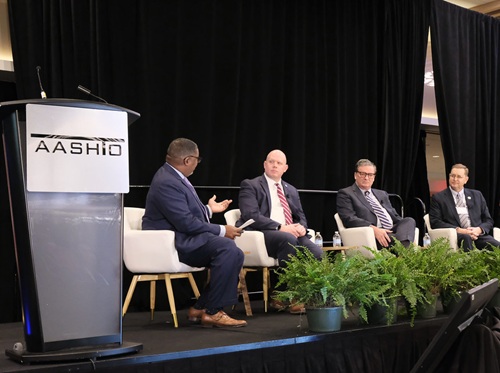At the recent American Association of State Highway and Transportation Officials 2025 Washington Briefing in Washington, D.C., a knowledge session focused on how state departments of transportation are working to improve disaster response efforts.
[Above photo by AASHTO]
Shawn Wilson, a vice president with consulting firm WSP and former secretary of the Louisiana Department of Transportation and Development, moderated the knowledge session, which featured: Justin Powell, secretary of the South Carolina Department of Transportation; Mike Carroll, secretary of the Pennsylvania Department of Transportation; and John Tyler, secretary of District Five for the Florida Department of Transportation and CEO of Sun Rail, Central Florida’s commuter rail system.
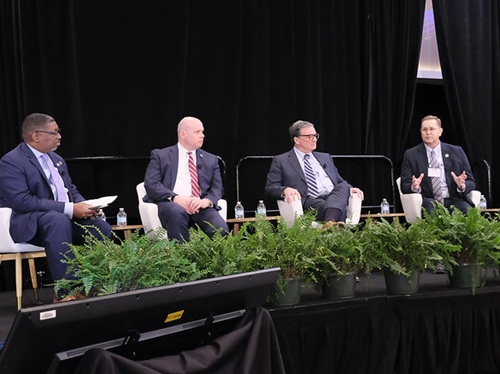
“One of the things we do is build ‘cadence’ in our organization,” SCDOT’s Powell explained. “Regardless of what kind of event we [go] through – we had major hurricane [Helene] last year and the upstate part of my state just went through a snowstorm in the coastal communities – we follow the same ‘battle rhythm’ every time.”
And Powell said that “battle rhythm” comes about by conducting regular drills throughout the year focused on building what he described as disaster response “muscle memory” across his department.
“It’s the practice and being consistent with how you’re going to respond to an event, regardless of what kind of event it is,” he said. “It’s about [emergency response] discipline, whether it’s a bridge collapse or a snowstorm, so everyone knows their role. That is the most important thing; that you’re not improvising in the middle of the storm. You’re following your procedures. That also helps you be more flexible and agile during [emergency] events.”
PennDOT’s Carroll noted that interagency coordination is vital, especially as disasters often affect more than one state. He pointed specifically to PennDOT’s experience following a tanker truck fire that destroyed part of I-95 in June 2023 – a major north/south freight and travel corridor that cuts across multiple states.
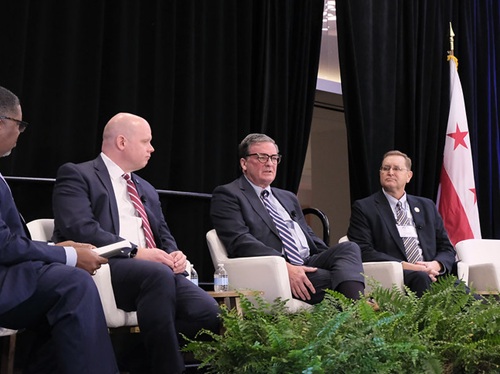
“That required tons of coordination on a local level, in coordination with our consultants and our contractors,” he said. “The National Guard and the state police were important partners for us, [as were] the New York State DOT and Ohio DOT. So it is not just about coordination among just state parties but also state partners, whether it’s state police or National Guard, and then local partners.”
Intra-state coordination was imperative as well, Carroll said, and it worked well. “We coordinated with the city of Philadelphia, the local police and fire departments, the Southeast Pennsylvania Transit Authority, and – to a smaller extent – the residents of that part of Philadelphia by the highway, with the accommodation of traffic movements, considering the severing of an interstate that carried 160,000 vehicles a day,” he said.
Carroll also stressed that federal agencies, including the Federal Highway Administration and the National Transportation Safety Board, also played critical roles as well.
“So overall we had federal, state, and local partners involved in the I-95 episode outside Philadelphia; all of them working together, respectful of their roles, but making sure that we met the needs of the folks in that region – and doing it safely,” Carroll said.
Florida DOT’s Tyler added that training for emergency situations never really ends, especially in states like his.
“I like to say that we have four seasons in central Florida. It starts with wildfire season; then we have tornado season; our longest season is hurricane season; and right on the backside of that is sinkhole season,” he said. “You’ve got to be prepared for it. It’s a full-time activity. We have full-time staff that are dedicated [to storm, response] but it’s really a potential full-time activity for everyone in the agency. Everyone is essential and we all can get called in. So we all need to be ready for that. That’s why when we’re done with hurricane season, we’re starting to talk about the next season.”
Tyler added another angle to being “flexible and agile” during emergency response operations; it also means being open to help from other public and private transportation firms – even ones from other states.
He believes accepting outside help to deal with emergencies – be it natural disasters or man-made issues – is a “sign of strength” for an agency, not weakness.
“It is important to take help from your neighbors and find a way to integrate them into your teams. We celebrate it, we showcase it,” Tyler emphasized. “And having those relationships in advance allows those conversations to take place very quickly and in a meaningful manner. Just say yes and then figure out how you’re going to work them in. Because we’re all in this together. We’re all in the same business. And it feels really good for that help to come in.”
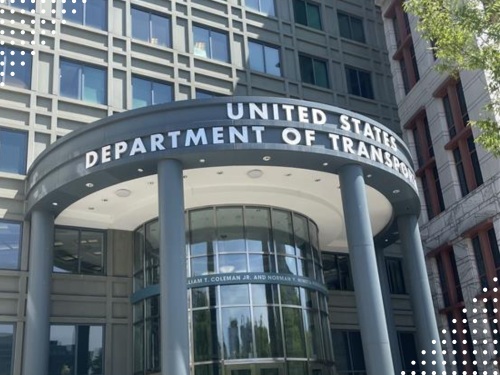 Top Stories
Top Stories
USDOT Makes $1.5B Worth of BUILD Grants Available
December 19, 2025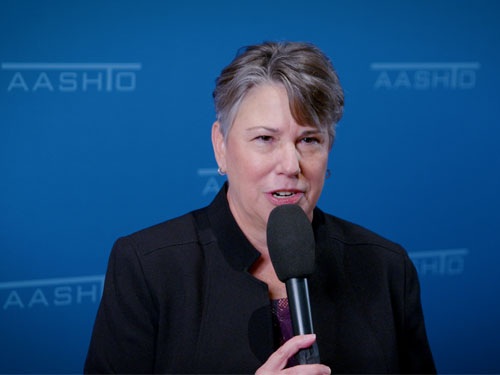 Top Stories
Top Stories
